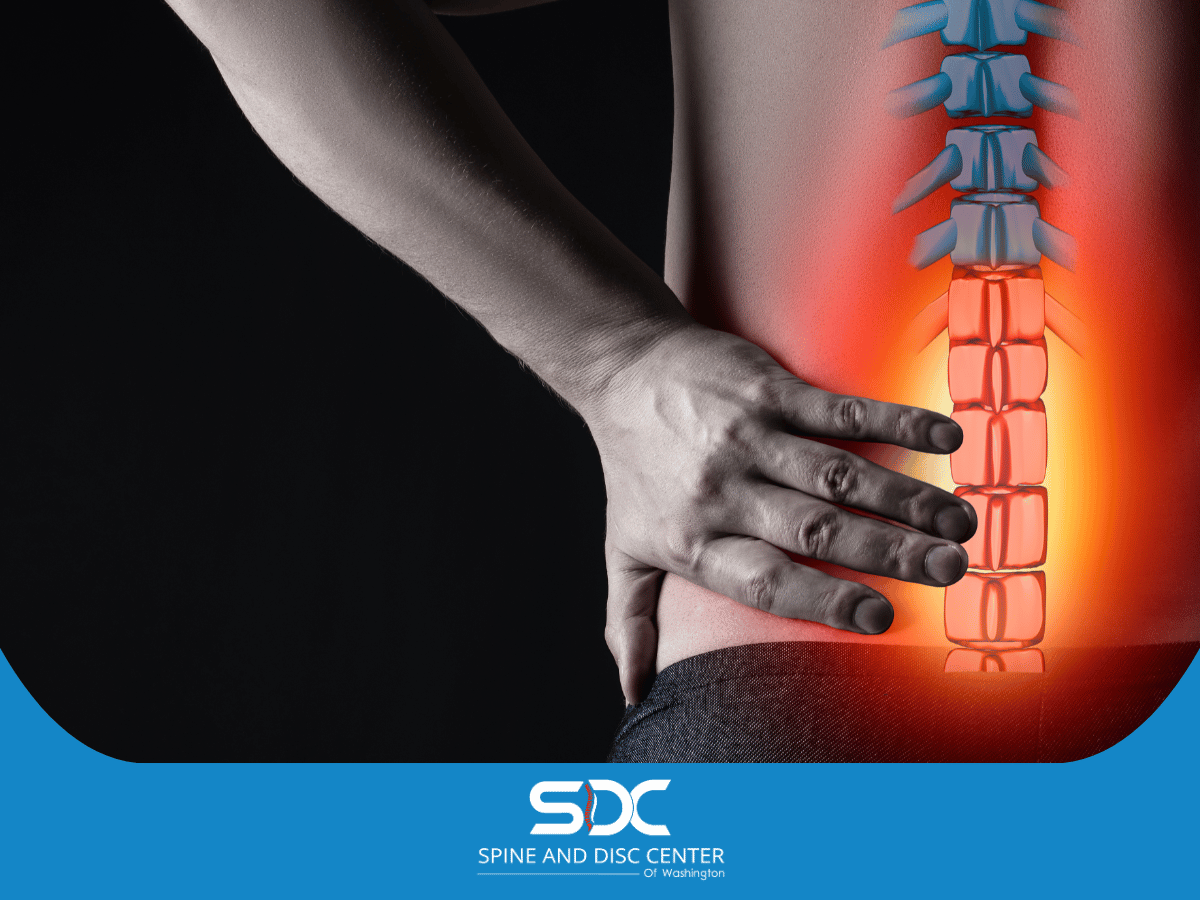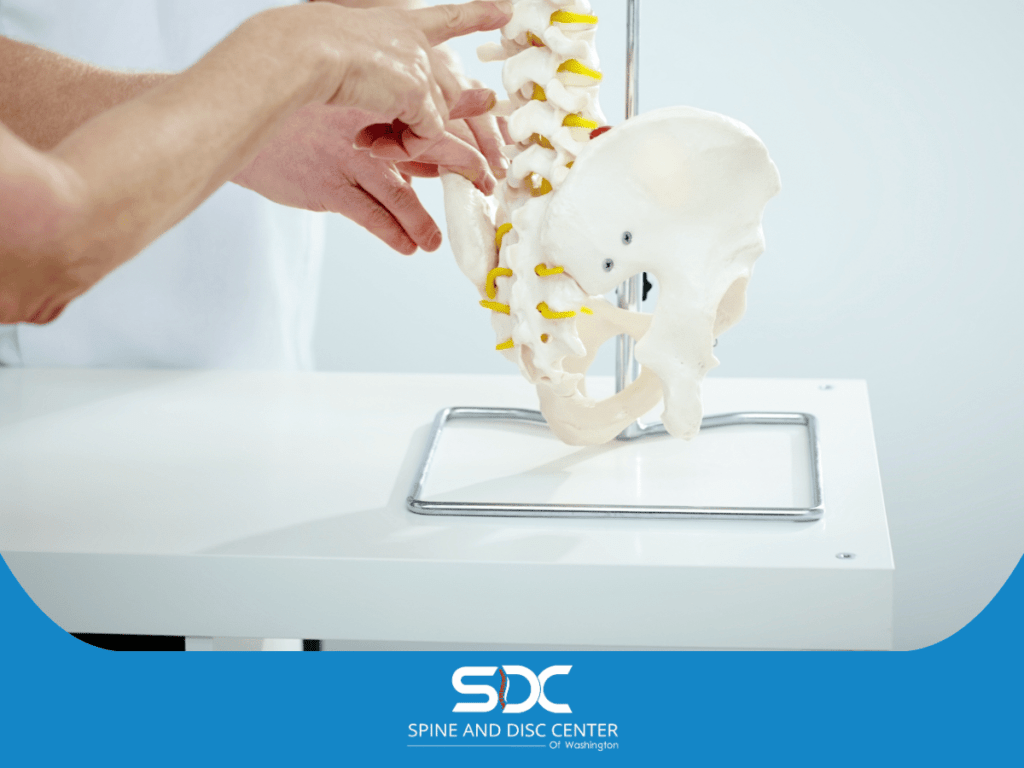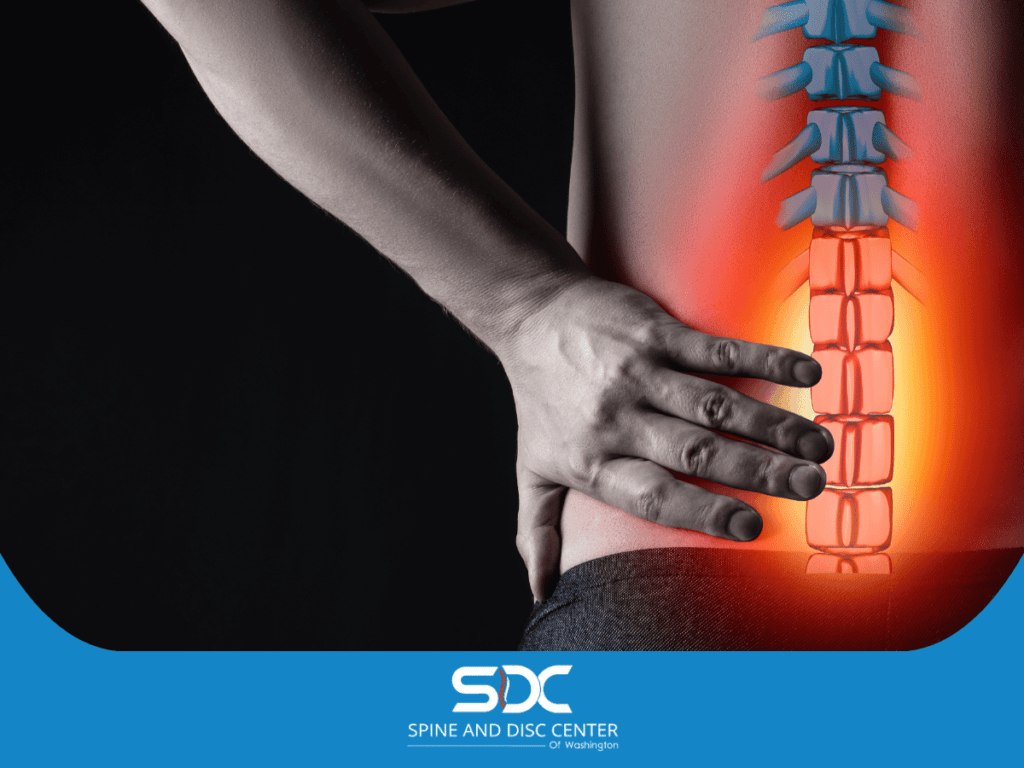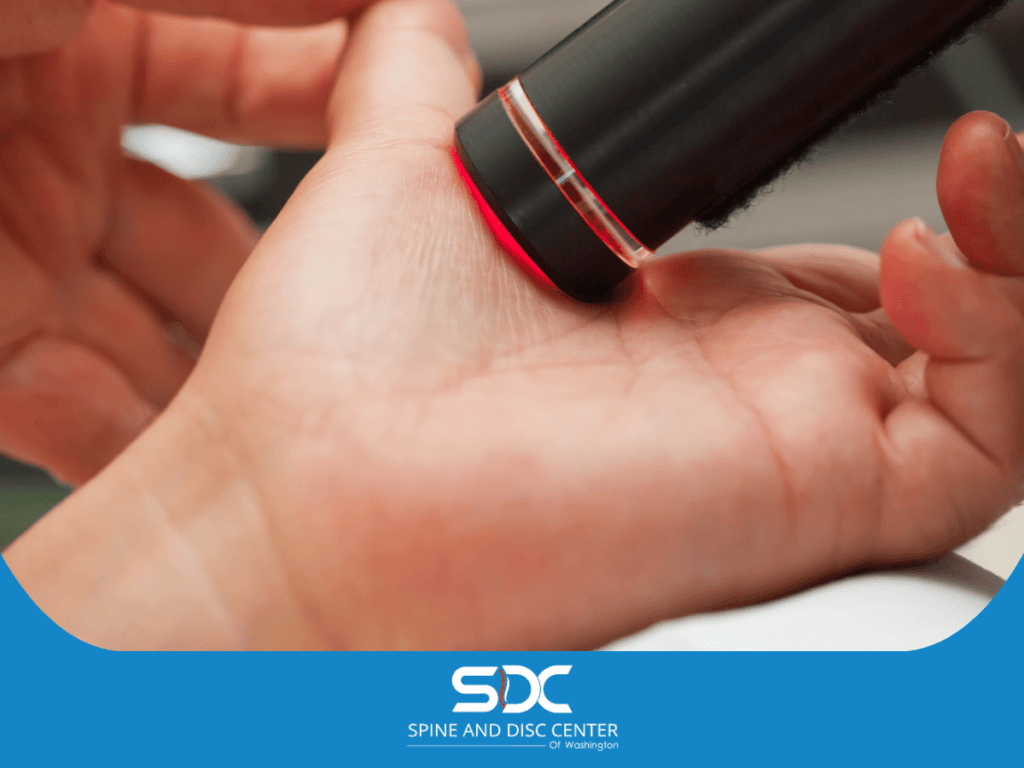Understanding the difference between sciatica and hamstring pain can be crucial for effective treatment and recovery. Both conditions affect the lower body but originate from different sources and require distinct treatment approaches.
This guide will help you identify the key differences between sciatica and hamstring pain and provide insights into their symptoms, causes, and treatments.
What is Sciatica?
Sciatica refers to pain that radiates along the path of the sciatic nerve, which runs from the lower back through the hips and buttocks and down each leg.
This type of pain, known as sciatic nerve pain, often has a gradual onset and can include shooting pain down the leg and potential numbness all the way down to the toes. It tends to get worse over time and can be more painful when sitting or standing for long periods of time.
Typically, sciatica affects only one side of the body. The pain can vary widely, from a mild ache to a sharp, burning sensation or excruciating pain. Sometimes, it can feel like a jolt or electric shock.
Causes of Sciatica
Sciatica is caused by irritation, inflammation, pinching, or compression of a nerve in the lower back, leading to nerve pain. Common causes include:
- Herniated Disc: A disc that has slipped out of place can compress the sciatic nerve.
- Spinal Stenosis: Narrowing of the spinal canal in the lower back.
- Piriformis Syndrome: When the piriformis muscle irritates the sciatic nerve.
- Degenerative Disc Disease: Breakdown of discs, which can lead to nerve compression.
- Spondylolisthesis: When one vertebra slips over another.
Symptoms of Sciatica
- Pain: Typically radiates from the lower back, through the buttock, and down the leg. This sciatic pain can be sharp or burning and is often worse with prolonged sitting or standing.
- Numbness or Weakness: In the leg or foot.
- Tingling Sensation: Commonly felt in the leg.
- Difficulty Moving: Severe pain can make it difficult to stand up or walk.
What is Hamstring Pain?
Hamstring pain is usually the result of a hamstring injury, which involves a strain or injury to the hamstring muscles located at the back of the thigh. These muscles are crucial for bending the knee and extending the hip.
Causes of Hamstring Pain
Hamstring pain typically arises from hamstring injuries, which can include:
- Hamstring Strain or Tear: Often due to overstretching or overloading the muscle.
- Pulled Hamstring: Sudden movement or exercise can lead to a pulled muscle.
- Muscle Tightness: Tight hamstrings are more susceptible to injury.
- Improper Warm-Up: Failing to warm up before physical activity can lead to injury.
- Weakness in Supporting Muscles: Imbalance in muscle strength can put additional strain on the hamstrings.
Symptoms of Hamstring Pain
- Sharp Pain: Sudden, severe pain during physical activity.
- Swelling and Bruising: May occur immediately after injury.
- Muscle Weakness: Difficulty in moving the leg.
- Tenderness: The back of the thigh feels tender to touch, often accompanied by hamstring tightness.
- Popping Sound: A popping or snapping sensation at the time of injury.
How to Tell the Difference Between Sciatica and Hamstring Pain
Understanding the differences between sciatica and hamstring pain involves looking at the source, symptoms, and type of pain.
Hamstring pain is typically a form of localized muscle pain, whereas sciatica often presents as a burning or radiating pain.
Source of Pain
- Sciatica: Originates from the sciatic nerve, typically due to compression or irritation in the lower back.
- Hamstring Pain: Originates from the hamstring muscle due to strain, tear, or tightness.
Symptoms
- Sciatica: Radiating pain from the lower back through the buttocks and down the leg. Sciatic nerve pain often has a gradual onset, with shooting pain down the leg and potential numbness all the way down to the toes.
It tends to get worse over time and can be more painful when sitting or standing for long periods of time. Associated with tingling, numbness, and weakness. - Hamstring Pain: Localized pain in the back of the thigh. Associated with muscle tenderness, swelling, and bruising.
Type of Pain
- Sciatica: Often described as shooting or electric shock-like nerve pain, worsened by prolonged sitting or standing.
- Hamstring Pain: Sharp, acute pain during physical activity, with possible muscle tightness and tenderness.
Quick Tests to Differentiate Between Sciatica and Hamstring Pain
You can perform several quick tests to help identify whether you are dealing with sciatica or hamstring pain.
Straight Leg Raise Test
- Lie flat on your back with both legs straight.
- Slowly raise one leg while keeping the other leg flat on the ground. If you feel pain localized to the back of the thigh, it may indicate a tight hamstring rather than sciatica. Sciatica pain typically radiates down the leg and into the foot.
- Lower the leg and repeat with the other leg.
Straight Leg Raise Test
- Sciatica: Lie on your back and lift one leg straight up. If lifting the leg causes pain to radiate down the leg, it may indicate sciatica. This test can help identify the need for exercises and stretches to relieve sciatic pain by strengthening and stabilizing the hamstring and low back.
- Hamstring Pain: If the pain is localized to the back of the thigh and doesn’t radiate below the knee, it may indicate a hamstring issue.
Sitting and Standing Positions
- Sciatica: Sitting or standing for extended periods often exacerbates the pain.
- Hamstring Pain: Discomfort increases with activities that stretch or load the hamstring, such as bending forward. Hamstring strains, a common injury caused by high-impact activities, sudden movements, or overuse, can also lead to significant discomfort.
Treatment Options
Effective treatment depends on accurately diagnosing the underlying cause of the pain.
Here’s how treatments for sciatica and hamstring pain differ:
To get hamstring strains fixed, it is crucial to seek professional care from a doctor or a skilled sports physiotherapist. They will diagnose thoroughly and create a treatment plan that may include exercises to improve flexibility and strength.
Techniques such as soft tissue release, deep tissue massage, and dry needling administered by a sports therapist can facilitate healing and prevent future injuries.
Treatment for Sciatica
- Physical Therapy: Exercises to improve posture, strengthen the back and core muscles, and increase flexibility. Specific stretches can help alleviate sciatic pain by targeting the affected areas and differentiating it from hamstring pain.
- Medications: Over-the-counter pain relievers, anti-inflammatory drugs, and muscle relaxants.
- Epidural Steroid Injections: Reduce inflammation and relieve pain.
- Surgical Intervention: In severe cases, surgery may be required to remove the source of nerve compression.
Treatment for Hamstring Pain
- Rest: Allow time for the muscle to heal, especially in cases of hamstring strains.
- Ice and Heat Therapy: Reduce swelling and pain.
- Compression and Elevation: Minimize swelling.
- Physical Therapy: Stretching and strengthening exercises to promote healing and prevent future injuries, particularly for hamstring strains.
- Medications: Over-the-counter pain relievers and anti-inflammatory drugs.
Preventing Sciatica and Hamstring Pain
Preventive measures can help reduce the risk of both sciatica and hamstring pain.
- Regular Stretching: Incorporate regular stretching exercises into your routine to maintain flexibility and reduce the risk of hamstring tightness. This can help prevent injuries and improve overall muscle health.
Preventing Sciatica
- Proper Posture: Maintain good posture, especially when sitting or standing for long periods, to prevent sciatic nerve pain.
- Regular Exercise: Strengthen the back and core muscles.
- Ergonomic Adjustments: Ensure that workstations and seating arrangements support good posture.
Preventing Hamstring Pain
- Warm-Up and Stretching: Proper warm-up and stretching before physical activity can help prevent hamstring injury and reduce the risk of hamstring pain.
- Strengthening Exercises: Focus on strengthening the hamstring muscles and their supporting muscles.
- Avoid Overloading: Gradually increase the intensity of workouts to avoid overloading the muscles.
Understanding the Healing Process
Both sciatica and hamstring pain involve a healing process that requires time and appropriate management.
Recovery from hamstring pain, particularly when it involves hamstring tightness, will vary based on the severity of the injury. Mild cases of hamstring tightness may take around two weeks to heal, while more severe cases could potentially take several months.
Healing Process for Sciatica
- Acute Phase: Focus on pain relief and reducing inflammation caused by sciatic pain.
- Subacute Phase: Begin gentle stretching and strengthening exercises.
- Recovery Phase: Gradually increase activity levels and continue physical therapy.
Healing Process for Hamstring Pain
- Initial Phase: Rest, ice, compression, and elevation (RICE) to reduce pain and swelling from hamstring strains.
- Rehabilitation Phase: Gradual introduction of stretching and strengthening exercises.
- Recovery Phase: Progressive return to normal activities, ensuring that the muscle has adequately healed.
Recognizing Severe Pain and When to Seek Medical Attention
It’s important to recognize when nerve pain worsens and when to seek medical attention.
Severe Sciatica Pain
- Unbearable Pain: If the pain is severe and unresponsive to over-the-counter medications, it may indicate sciatic nerve pain.
This type of pain often has a gradual onset, with shooting pain down the leg and potential numbness all the way down to the toes. It tends to get worse over time and can be more painful when sitting or standing for long periods of time. - Loss of Bladder or Bowel Control: Indicates a medical emergency known as cauda equina syndrome.
- Progressive Weakness: Worsening weakness in the legs.
Severe Hamstring Pain
- Significant Swelling or Bruising: May indicate a severe muscle tear.
- Inability to Bear Weight: If you cannot put weight on the affected leg.
- Severe Pain with a Popping Sound: Suggests a complete tear or rupture of the muscle, often associated with a hamstring injury.
Role of Physical Therapy in Managing Sciatica and Hamstring Pain
Physical therapy plays a crucial role in managing and recovering from sciatica and hamstring pain. Seeking professional care from a doctor or a skilled sports physiotherapist is essential to fixing hamstring strains.
They can diagnose properly, create a tailored treatment plan, and guide you through exercises to improve flexibility and strength. Techniques such as soft tissue release, deep tissue massage, and dry needling administered by a sports therapist can facilitate healing and prevent future injuries.
Physical Therapy for Sciatica
- Stretching Exercises: To improve flexibility and reduce nerve irritation.
- Strengthening Exercises: Focus on the back, core, and lower body muscles to relieve sciatic pain and prevent its recurrence.
- Postural Training: Teach proper posture and body mechanics to prevent future episodes.
Physical Therapy for Hamstring Pain
- Stretching and Strengthening: Exercises to restore flexibility and strength in the hamstring muscles, which is crucial for treating hamstring strains.
- Functional Training: Focus on movements and activities that mimic daily life and sports activities.
- Progressive Loading: Gradual increase in exercise intensity to prepare the muscles for return to normal activity.
Importance of a Proper Diagnosis
A proper diagnosis is essential for effective treatment and recovery of a hamstring injury. Misdiagnosis can lead to inappropriate treatments and prolonged pain.
Diagnostic Techniques
- Medical History and Physical Examination: To assess symptoms and identify the underlying cause, including differentiating between hamstring pain and sciatic nerve pain.
Sciatic nerve pain typically has a gradual onset, with shooting pain down the leg and potential numbness all the way down to the toes. It tends to worsen over time and can be more painful when sitting or standing for long periods of time. - Imaging Studies: MRI or ultrasound to visualize the affected area and confirm the diagnosis.
- Nerve Conduction Studies: To evaluate nerve function in cases of suspected sciatica.
Developing a Comprehensive Treatment Plan
A comprehensive treatment plan addresses the underlying cause, alleviates pain, and promotes healing. For instance, if you are dealing with hamstring pain, it is crucial to consider the severity of the injury.
Hamstring tightness can vary in recovery time, with mild cases taking around two weeks and more severe cases potentially taking several months.
Treatment Plan for Sciatica
- Initial Pain Management: Medications, physical therapy, and possibly injections to alleviate sciatic pain.
- Rehabilitation: Gradual increase in activity levels and exercises to strengthen the back and core.
- Long-Term Management: Lifestyle changes and preventive measures to avoid recurrence.
Treatment Plan for Hamstring Pain
- Immediate Care: For hamstring pain and hamstring strains, rest, ice, compression, and elevation (RICE) are essential.
- Rehabilitation: Stretching and strengthening exercises to restore function.
- Preventive Measures: Warm-up routines and strengthening exercises to prevent future injuries.
Conclusion
Distinguishing between sciatica and hamstring pain is crucial for effective treatment and recovery.
Understanding each condition’s symptoms, causes, and treatment options can help you manage your pain and improve your quality of life.
Always seek a proper diagnosis from a healthcare provider to ensure the most appropriate treatment plan is developed for your specific condition.
Final Thoughts
This blog post is intended for informational purposes only and should not be blindly followed. It is not a substitute for professional medical advice, diagnosis, or treatment.
Please schedule an appointment with a qualified healthcare provider for personalized diagnostic and guidance tailored to your specific condition.


